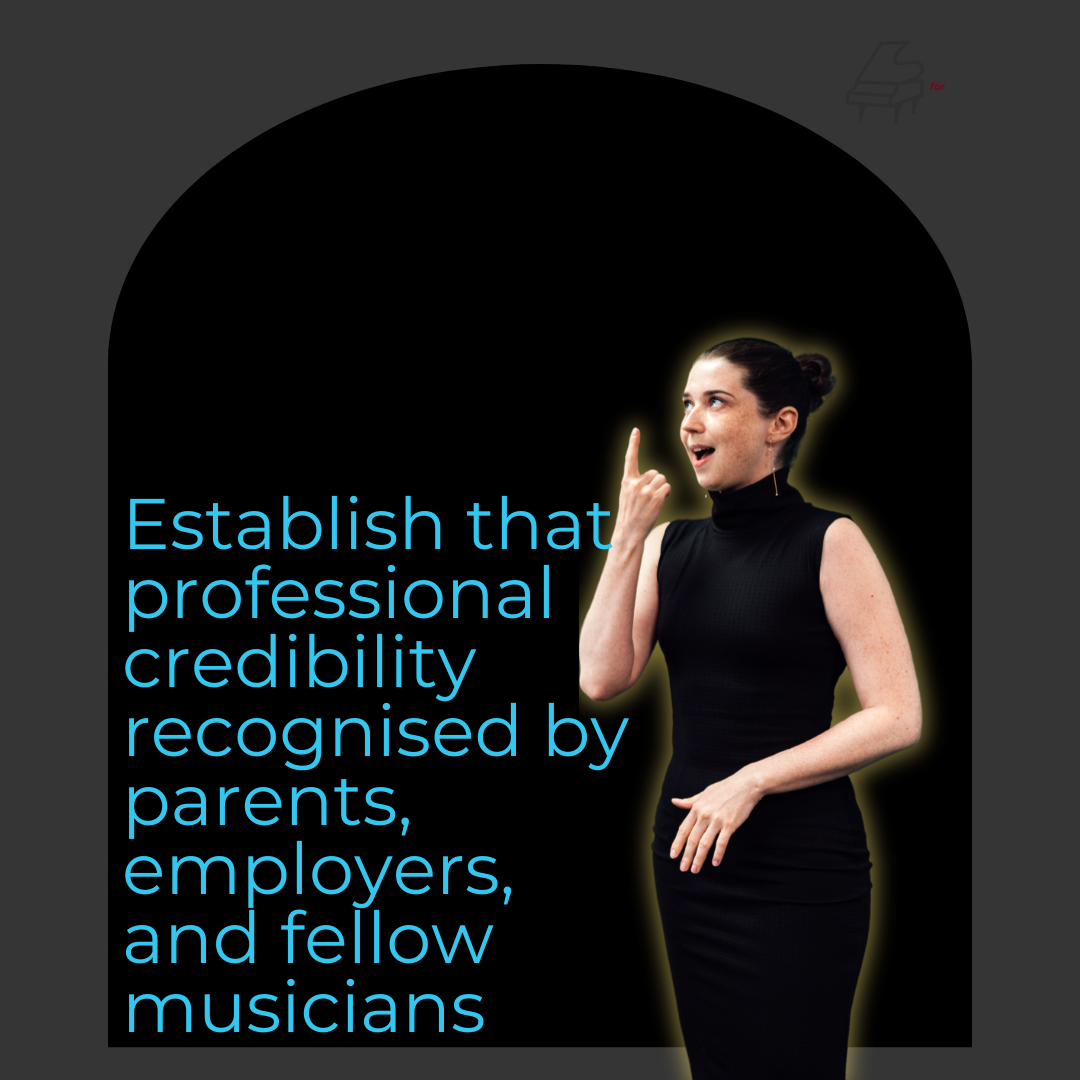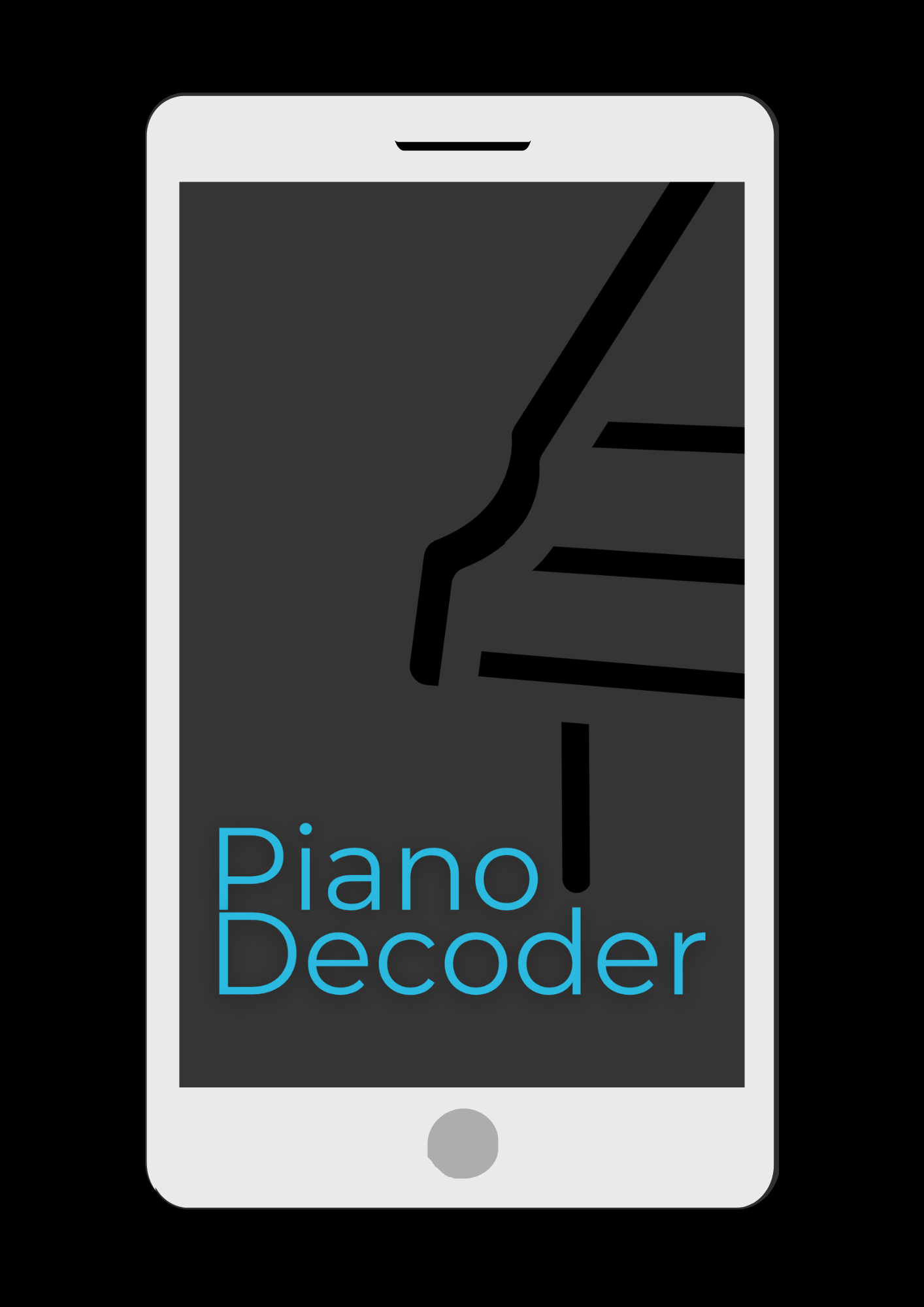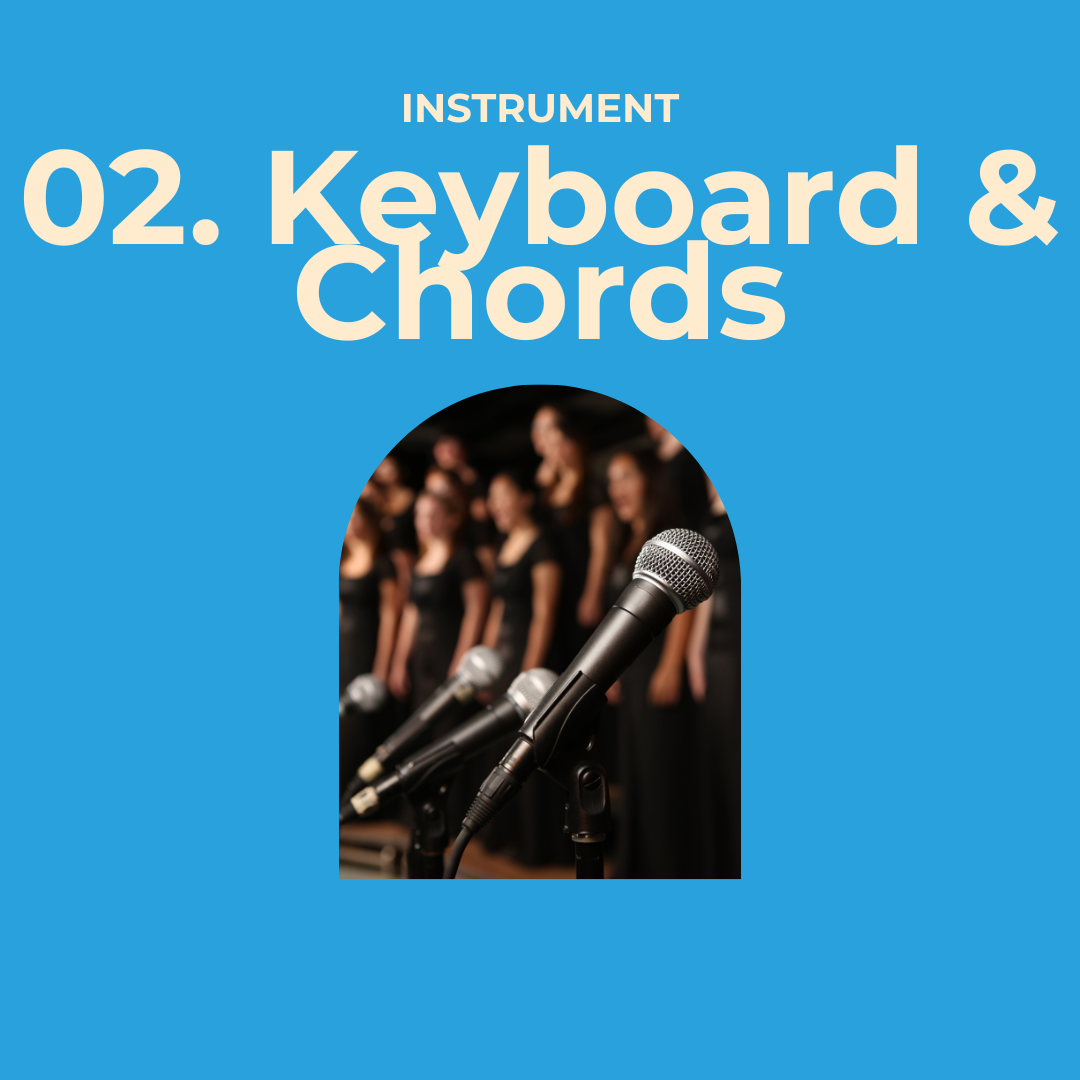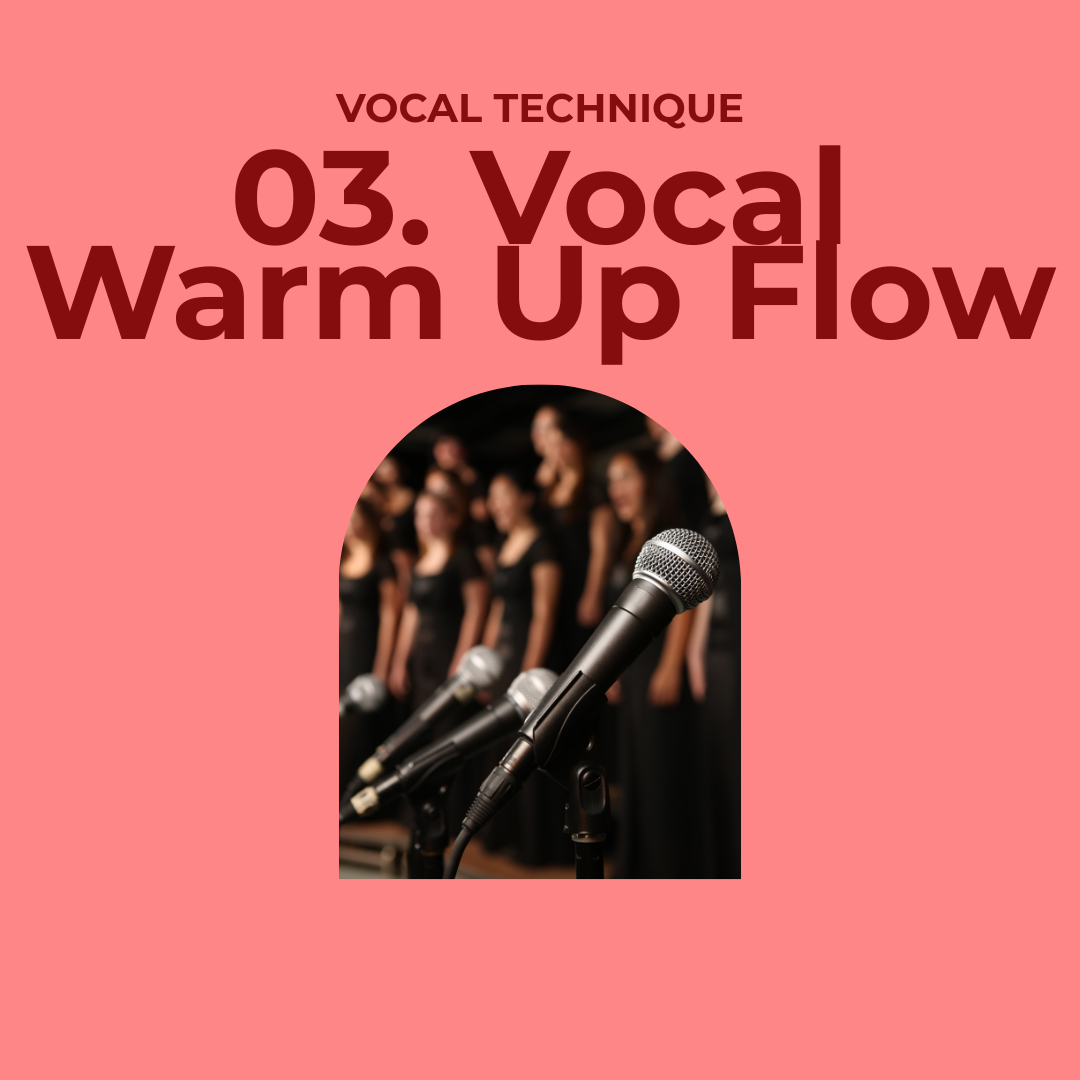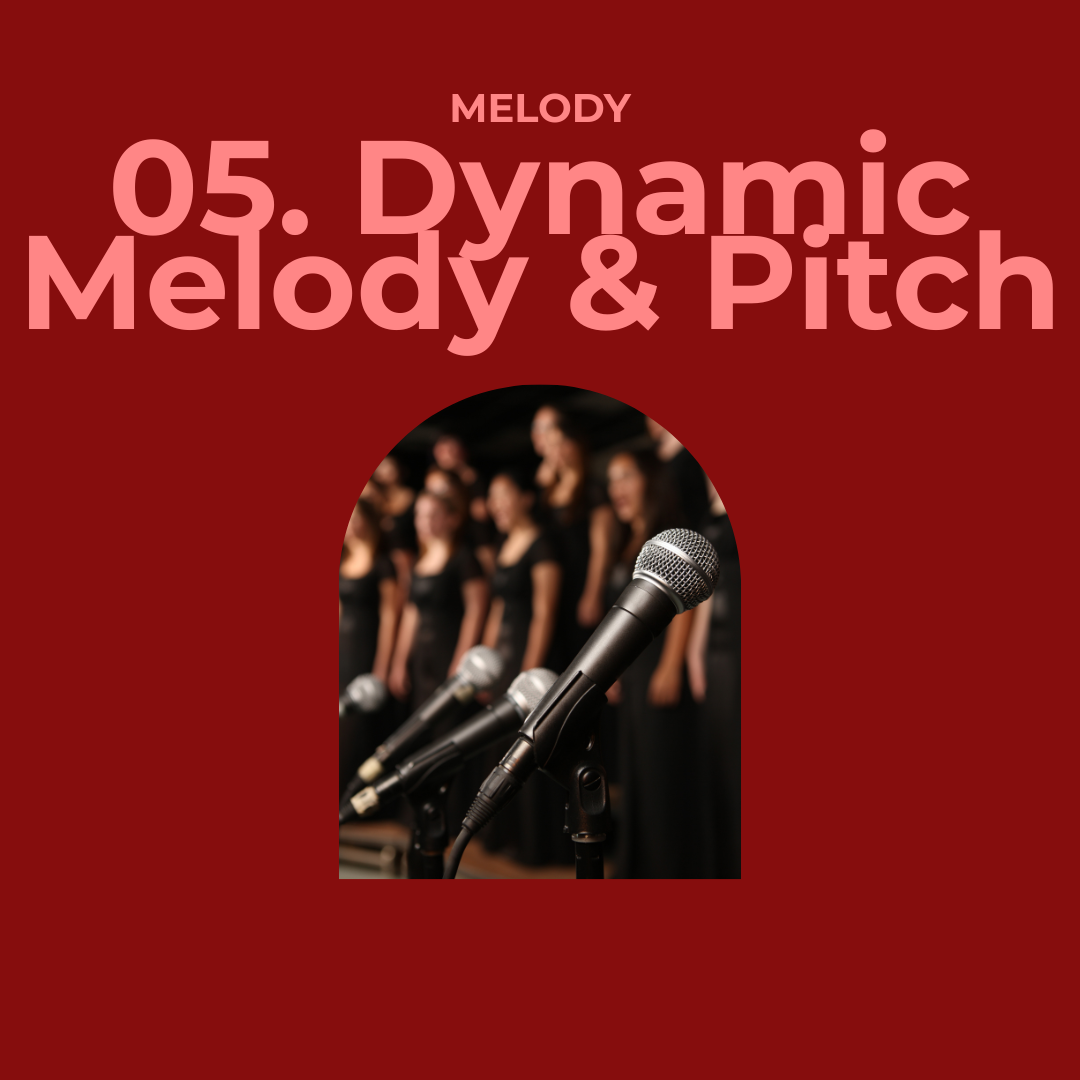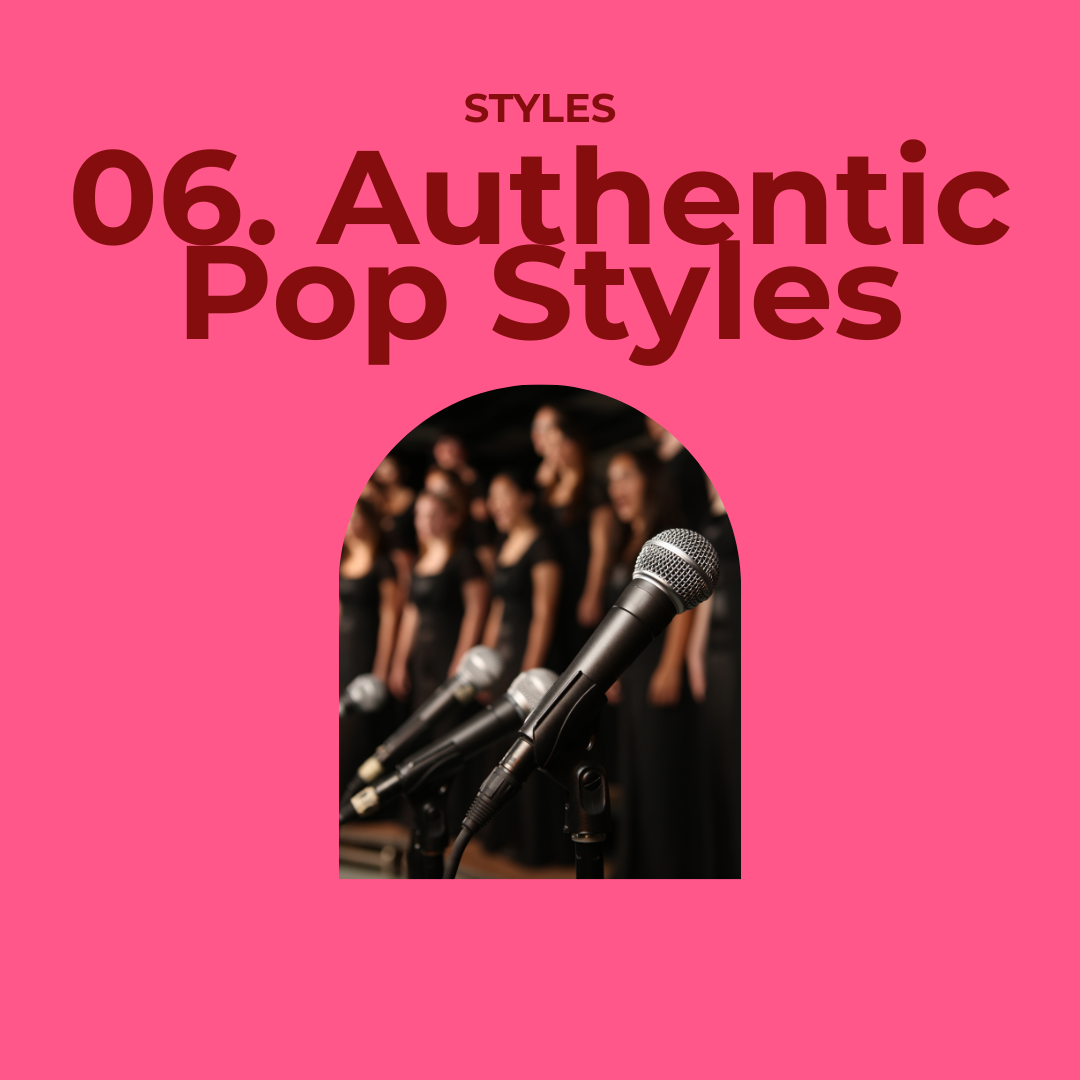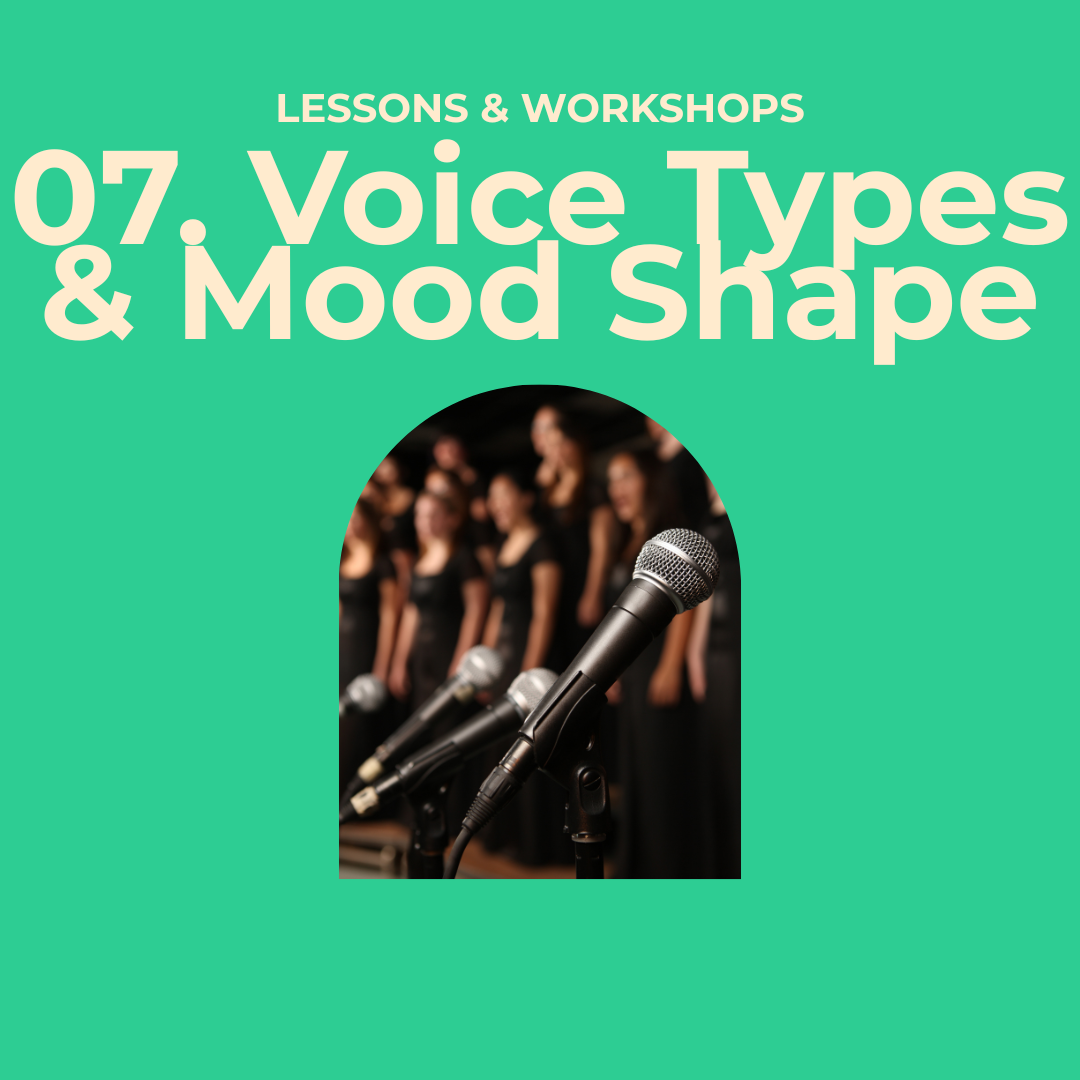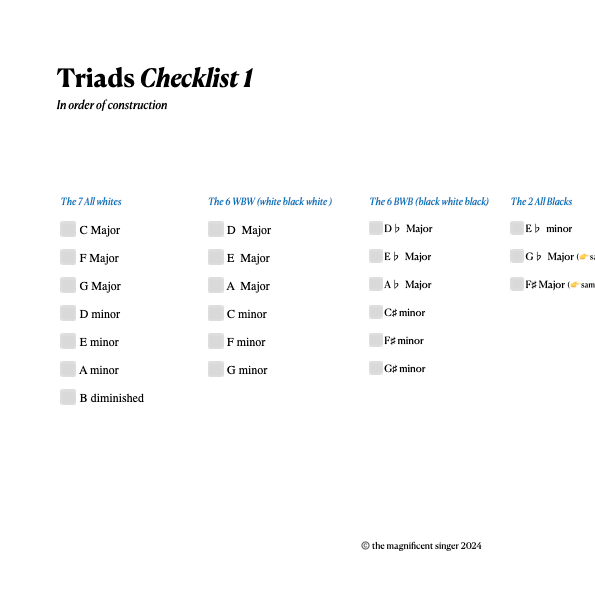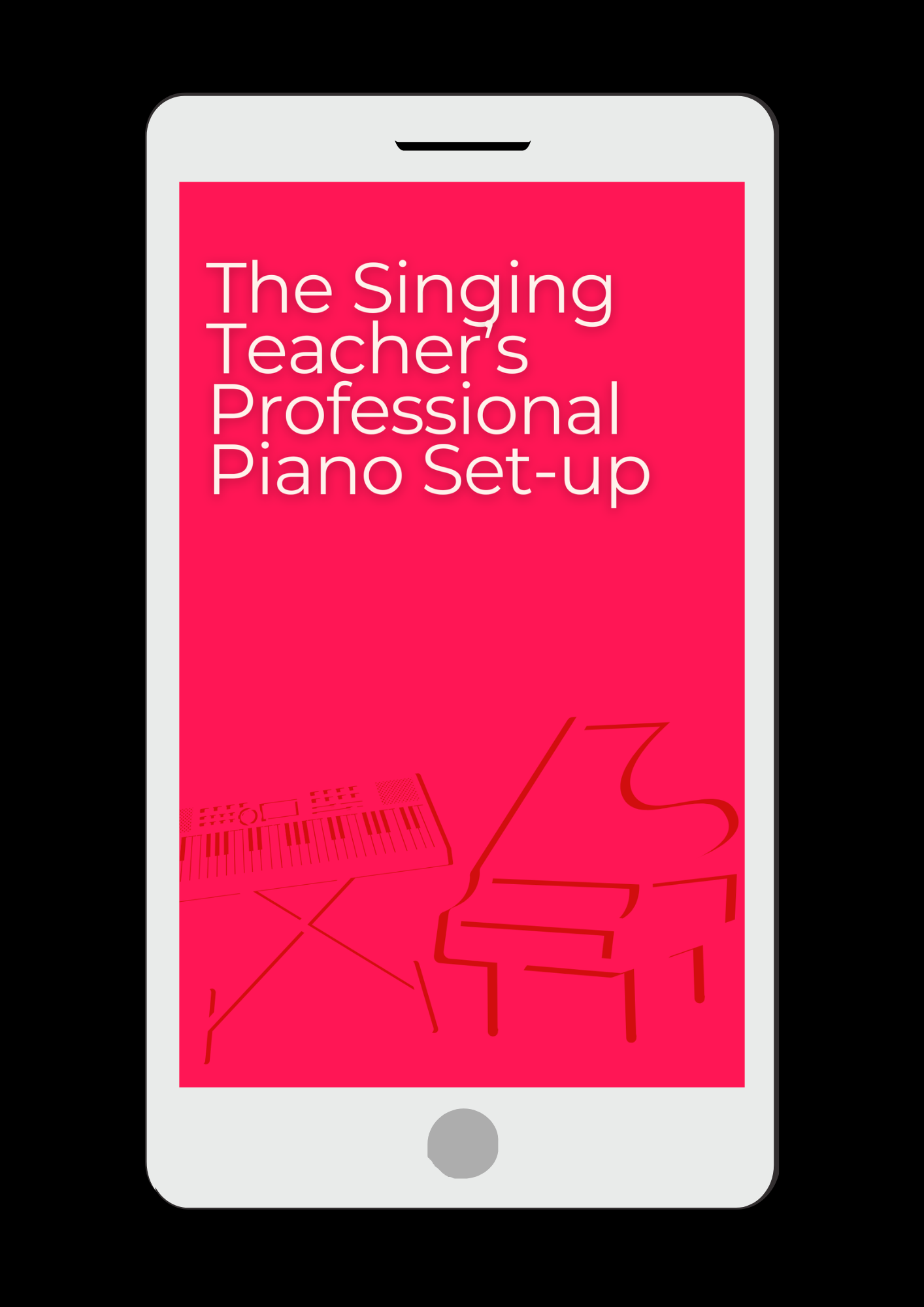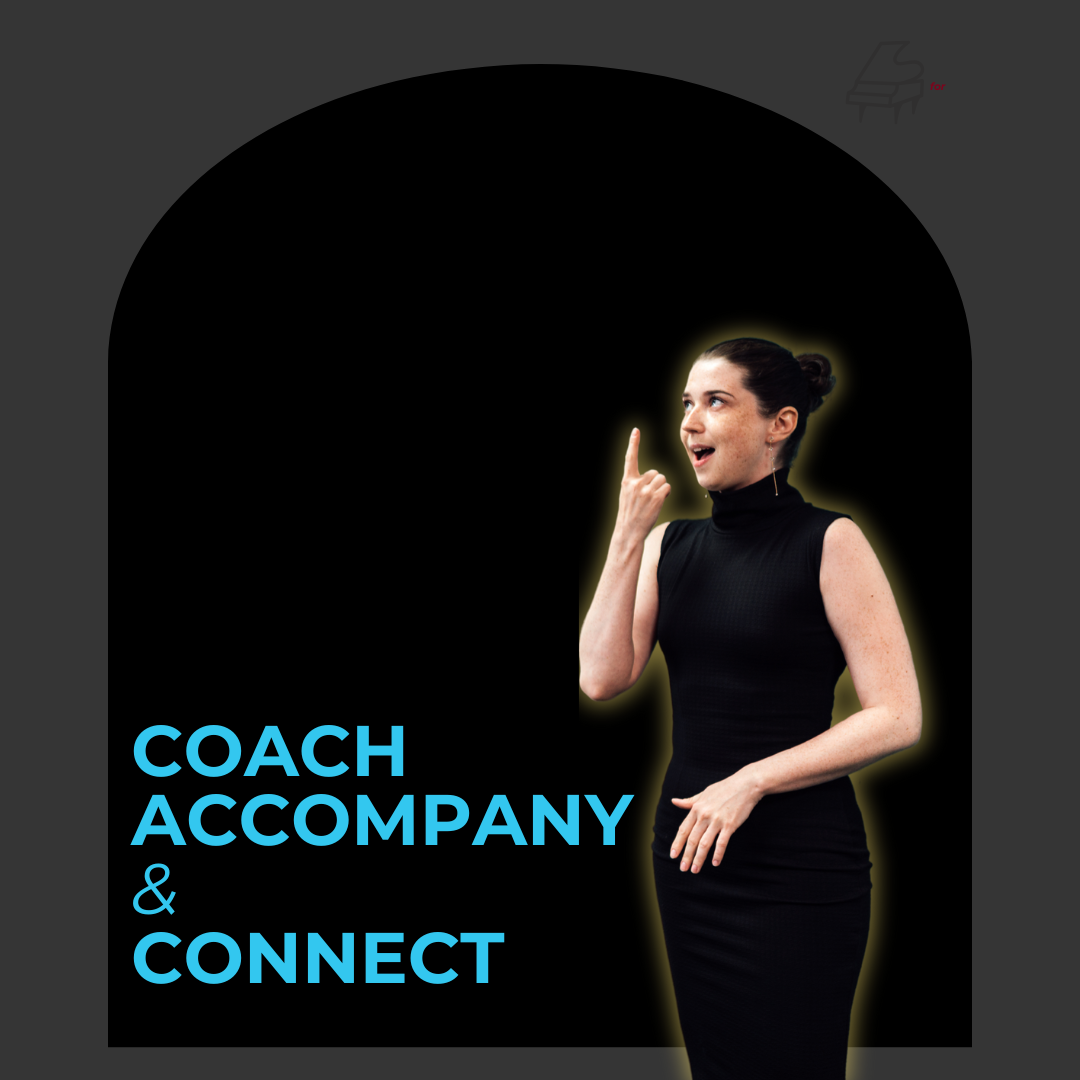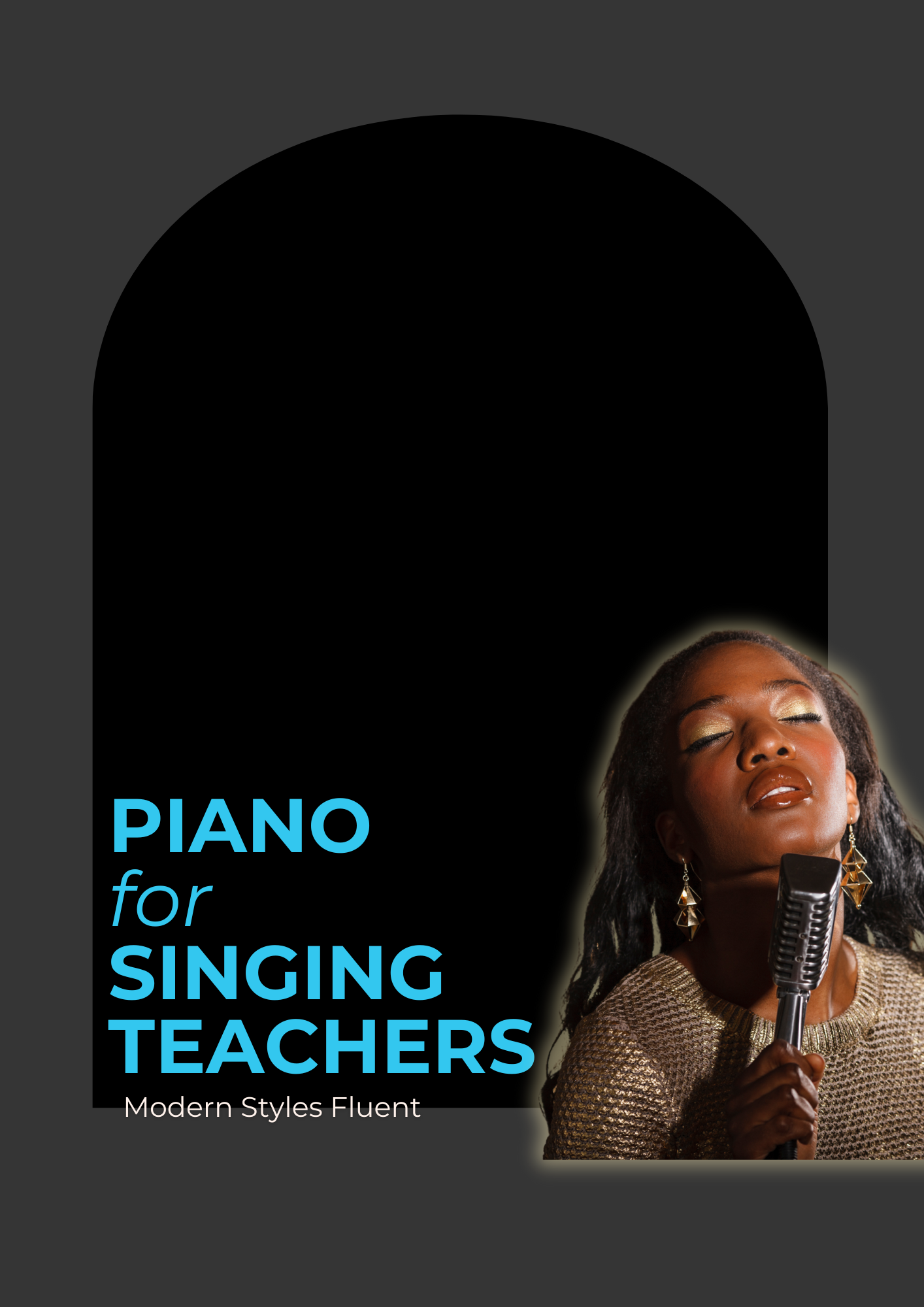“Your piano for singers course was so amazing. I can now play fairly skilful piano from zero (or one fingered synth) and I use your skills every day. You are such a naturally great teacher too.”
—Ed Staunton (London)
Director and Vocal Coach at Soho Vocal Tuition

✦ Piano for Singing Teachers —Lesson-Ready Piano.
Get the exact essential piano skills that fit your teaching style — so you can confidently lead one-to-one lessons, pop choirs, or classroom sessions without backing tracks or overwhelm.

Go from:
Avoiding or underusing piano in lessons and workshops
Relying on YouTube, backing tracks, and generic warm-ups exercise patterns
Lost with chords or having to spend weeks practicing up just one song only to teach it once
Struggling to deliver the high quality 121 singing lesson, class or workshop you are capable of
Highly concerned your students are not getting a top level and complete singing lesson
Feeling embarrassed playing in front of students, parents and colleagues
Frustrated at not being able to teach comprehensively your best through gaps in their ability to cross the communication gap.
Limited in your professional teaching ‘tools’
Feeling being considered less good than other teachers
Having to hire accompanists and feeling second-rate next to teachers who can play
To:
Using the piano to play simple, musical and supportive song accompaniments straight from a song sheet
Expertly using the piano to teach and coach
Play authentic pop accompaniments
Run flexible warm-ups
Break down melodies on the fl
Lead your classes straight from the piano with confidence — without needing hours of practice or a classical diploma.
And feel good about putting yourself ‘out there’ as a teacher with something in-demand to offer.
Having a lasting collection of piano skills aligned to your current and future career goals
Personalising warm-ups on the spot for 121s and workshops
Filming short practice videos breaking down song melody in their ‘best key’
Confidently showcasing your teaching in lessons, interviews, and community settings
Effortless key changes
Without:
Grinding through endless piano practice you don’t have time (or enthusiasm) for.
Learning nice-to-have piano techniques that ulimately don’t support your singing teaching or future career choices

Chances are you love being a singing teacher.
You love sharing, helping, watching your students grow.
And for the most part, you feel you’ve got something valuable to offer.
But every now and then, you hit a problem:
A melody you’d love to break down—if only you could play it.
A song accompaniment you wish you could just sit down and do.
A student walks in with a chart—expecting you to play.
Or asks to try it in another key.
A job you’d love to go for… if only piano wasn’t part of the brief.
A parent with expectations that don’t quite fit who you are.
Technical things you’d love to tweak—show them how to do sing it better.
Maybe you’ve tried learning piano
Had some lessons, watched a few videos, perhaps signed up for a 10-week “piano course.”
And been quite dismayed at the long road ahead.
It seems like a LOT of practice. Never-ending practice, too.
And you don’t really have the time to devote to pure piano — or, if you’re honest, the enthusiasm. After all, you’re a singer!
Or maybe you’ve simply never had the opportunity. You’d loveto get going but you’re not sure where to start.
And this is the problem with the legacy is huge — classical repertoire, jazz improv, latin grooves. And that’s before we’ve got to the keyboard!
Th good news is you don’t need it all. And infact advanced piano can actually get in the way of teaching singing well.
Which is why standard piano lessons don’t always specifically help singing teachers. Why piano lessons don’t always help singing teachers
Because, funnily enough — piano lessons teach you how to be a pianist. Shocker
Meaning learning repertoire, making a beauftul sound, reading.
Excellent if you are in for the long haul of piano.
But for many singing teachers piano is not a priority. And actually they are not wanting piano as such — they are wanting to help their students sing better.
Because although you do get the student who loves singing with live piano — ultimately , they want to be a better singer — and you to help them with that. Flashy piano can get in the way.
You are learning piano for singing — which is different in itself
And it gets even more specialised: you need piano for teaching singing.
So singing teachers actually need 3 things from the piano:
the ability to xxx
and xxx
they also — because
the payoff is of course the obvious stuff — and that’s very nice
but in my experience
All teh singing teachers I
they also have a uniuq way of crossong the — thinking abut singing.
you coudl think of it as a
your unique methodology
And it’s a good thing to have
because it can genuinely help someone struggling with tehir singing — who will fall on you with joy
So in these days of nt just the only singing teacher
Future proof your singing teaching
Because you are not actually learning piano in the traditional sense! (Very close obviously)
you don’t need to be concert pianist worth — strong piano skills can actualy get in the way
you need 2 things — the ability to loistne
we help you figure the 2nd in our piano decoder + plan
And then we heklp you get the 1st — challenges, micro videos,
and while we at it we assume 3 things
as much as possible as you actually reach
The most important thing you need is to play and listen to your students —
Which means piano needs to be literally under your finders . Instinctive.
And the other good news it doesn’t need to be complicated . Unless you’re specialised (see other course). Your singing students want to sing better. They are not interested in virosoc piano playing etc (and actually it can get in the way)
Standard piano will lessons -big surprise! - teach you how to play the piano.
Whic means: learning pieces, working up a nice touch, understanding notes, perhaps some chords and improv too
Okay —that sounds good but I need this right?
Yes and no. Depends if you are in piano for the long haul.
Piano lessons and piano courses teach you to be a pianist.
Wonderful if you’re in for the long haul of learning piano.
Singing teachers need two things from their piano:
1) The ability to play and genuinely listen to their student
2) The collection of piano skills that support their singing teaching methodology and student type.
So if your focus is teaching singing or coaching vocals – some of the piano stuff covered in straightfoward piano lessons aren’t always necessary.
And can instead by a distraction.
Learning “3 Blind Mice” doesn’t feel that relevant to a singing teacher with a hefty schedule
I’ve worked alongside and taught enough singing teachers to know we are all different, but the common ground is we all care about our students.
So it’s super exciting how our world is no longer just about being the “only singing teacher in the village” –we can genuinely delve deep into our specialist area.
Piano for Singing Teachers 1 teaches you to be a more individual, nuanced singing teacher—using piano as a teaching tool.
It’s not about piano grades. And it’s definitely not about playing Chopin.
It’s about getting the piano you need for your teaching… both current and in the future.
to build trust and rapport with your students.
draw out the best from your 1:1 sessions and workshops.
open yourself to the career advantages of having professional piano for teaching singing.
Tap into the piano advantage
“Research in vocal pedagogy shows that skilled piano accompaniment makes singers perform more accurately and emotionally”
—ICATPE, 2019

What you could learn in Singing Lesson-Ready Piano
The stuff they need to make this happen…
#1 A Pianistic Finish
—How to play piano pianistically and musicially so you don’t
—Play musically yet simply — your singing teaching ears will be frustrated at producing plonky, amateur sounding piano. You don’t need to play anything fastm impressive or compicated — you just need
—How to use the pedal — and when not to use the pedal
Gain a Pianist Touch
#2 Vocal Warm Ups
How to play a variety of vocal warm ups patterns under the fingers
How to understand voice types on the piano and where to play to support range
Have a contrasting set of LH patterns
Use the piano to be spontaneous and flexibkle with vocal warm ups — have he flexibiklity to slow it down, shift keys, accomodate teh quiet songer energise the sleepy class, lead with authroity with the suspicious large, settle down teh char-tty evening class. All these toles become easier with a piano on your side
How to play the standard vocal warm-ups in every key — without losing your place or momentum mid-exercise.
How to create warm-ups that match your student’s voice and goals — so you’re not stuck using the same scale over and over.
—How to play every warm-up for any voice type, in any key, without stopping — so lessons flow and students stay focused.
—How to personalise technical exercises to suit your student — and develop your own teaching approach as a result.
—How to use the piano to energise, focus or
Legimately include piano on your CV
Problem solve
Have a variety of
Be open to
have a powerf
not wear your singing and speaking voive
increase musiciahip skills that don’t also crodss the path os a singer as itys nit a priority — ballabce your skill anf musicship —
and then
#3 Song Interpretation & Delivery
The ability to embellish — give yiur students an invaluable making music live listening experience — this is critical for singers withut a musicianship background who have learnt by copying, Oneof those hidden diffientiaters
A small set of patterns — to draw out dynamics, energy and flow — help your student sdeliver their song story
How to play authentic sounding as-good-as-the-realthing if not better pop style song accompaniments
#3 Reading Sheet Music & Chord Charts
How to play from popular style song charts at a glance
How to play chords in all keys with voicings to supprt teh singing voice
How to
#4 Teaching Melody & Matching Pitch
How to be able to pick out the melody and teach slowly — and be prepared to shift keys
ff
ff
#5 Singing Teachers Piano
How to develop the ability to play and listen to yoru student at the same same
Protect their own singing and speaking voice — an dthat incldues the body postureSave your singing voice and speaking voice for important events
A process for progress — during busy weeks when you just dont have time to think. Practice as you teach
No fuss switch between keys — chords for songs, exercises,
Having options for problem solving during lessons.
And be quietly assured about the balance of tracks, voice demo and piano— probably instinctive — but not a bad question to reflect on. This allows you to differentiate between yourself and other singing teachers — whicg is one imprtant peg in teh being reffered slot.
#6 Career
Understand clearly what they offer on teh piano and the implications for students, heads of departmets and parents
Not get brain clutter — feel overwhelemd by all the possibilities of the legacy of the piano. Get very clear on what they need to support their singing students - bith current and future — and have made decisons aboyt what they are cheerfully saying no to learning. Helps the hiring in decison much easier . And the job application process.
Piano Confidence. Happy to play in front f parents, students, fellow teaching pedagogues , even the internet if that’s your bag,
Your singing may be overwhelming , intimitating
#4 Chords
The foundation of commercial style playing.
#5
The foundation of commercial style playing.
#6 A balanced teaching offer
Confidence comes with knowing our doing and the experience of having done it
#7 Flexible Vocal Warm Ups
#8 Professional Expertise Short cuts Signals
Use the piano to be spontaneous and flexibkle with vocal warm ups — have he flexibiklity to slow it down, shift keys, accomodate teh quiet songer energise the sleepy class, lead with authroity with the suspicious large, settle down teh char-tty evening class. All these toles become easier with a piano on your side. Whereas there can — everyone recognises the skills gap
#9 Get claer on Professional boundaroes
The world of music and the legacy of piano is huge. Feel confident about what you bring
Get the piano for your actual singing teaching needs (not generic piano methods). \
bed piano practice into your real teaching week.
Em Enjoy it — not a time-consuming chore
8-week online piano accelerator for time-strapped singing teachers and vocal coaches who teach pop, and musical theatre styles — and want to feel confident at the piano.
Just practical, enjoyable piano training — taught by an expert who understands singing teachers (not a pianist guessing what you need
Learn to play read melodies, accompany songs, and handle mid-lesson hiccups with ease.
— break down melody
—effortless switching of keys
—
03. Not having to practice up song charts
—understanding chords and feel
—getting a commercial styles rhythm and groove
—
04. make musical song accompaniment s— nit plonky fot pop ballad
—
—
—
05. Feel like you c
06. Feel confidence in what you bring and what you don’t bring
—
Personalised and standard Vocal warm ups
song accompaniment — xpatterns, chords,
Teaching melody + matching pictch
Authentic Styles
Rhythm
No thinl song charts
Not imposter
Help your student ssing better
Stay relevant and up to daye
Career — draw out your methododloy
1. Vocal Warm Ups
✓How to read and play simple melody lines confidently — even if notation feels intimidating.
✓How to break down melodies for pitch and phrasing work using the “Melody Skeleton” method.
✓How to switch keys on the spot when your student needs it (with calm, competence, and flair).
Access vocal warm ups — all the standard ones plus a few more, and to be flexible enough to switch them up as needed in that moment — to energise, to access body work and tap into creative ideas
Personalise vocal warm ups to bring out phrasing styles and help them develop their artistry and aesthetic
2. No-prep Song Charts
✓How to read and play simple melody lines confidently — even if notation feels intimidating.
✓How to break down melodies for pitch and phrasing work using the “Melody Skeleton” method.
✓How to switch keys on the spot when your student needs it (with calm, competence, and flair).
3. Teaching Melody
✓How to read and play simple melody lines confidently — even if notation feels intimidating.
✓How to break down melodies for pitch and phrasing work using the “Melody Skeleton” method.
✓How to switch keys on the spot when your student needs it (with calm, competence, and flair).
Slowly breakdown that tricky melody helping the student match pitch and get in the middle of the note
4. Help your student sing better
✓How to read and play simple melody lines confidently — even if notation feels intimidating.
✓How to break down melodies for pitch and phrasing work using the “Melody Skeleton” method.
✓How to switch keys on the spot when your student needs it (with calm, competence, and flair).
Help the student experiment with different keys, dynamics and tempos for their songs
Help students prep for live performance, auditions and masterclasses
5. Teaching Melody
✓How to read and play simple melody lines confidently — even if notation feels intimidating.
✓How to break down melodies for pitch and phrasing work using the “Melody Skeleton” method.
✓How to switch keys on the spot when your student needs it (with calm, competence, and flair).
Accompany singing students in a broad range of styles from simple chord sheets
6. Career Confidence
✓How to read and play simple melody lines confidently — even if notation feels intimidating.
✓How to break down melodies for pitch and phrasing work using the “Melody Skeleton” method.
✓How to switch keys on the spot when your student needs it (with calm, competence, and flair).
Single-handedly run large group rehearsals
01. No more track or Youtube video dependence.
Finally be free from relying entirely on backing tracks and not-quite-right YouTube videos
Play what you need, when you need it —exercises, song accompaniment
live, musical, and on your own terms.
02. Pick up and play — beautifully.
sit down and make it sound musical without having to practice for hours beforehand
Pop ballad, chart hit, or musical theatre number
Guide your student artistically and technically.
03. Flexible warm-ups at your fingertips.
You’ll be able to adjust any vocal exercise instantly — any voice, any key, any moment
— keeping lessons fluid, responsive, and professional.
No fumbling for the right note or key again.
In this adaptable course, you’ll learn the piano you need to open up career opportunities and confidently teach pop and musical theatre singing from your approach at your best.
This isn’t a one-size-fits-all-fixed course. But singing teachers and vocal coaches have common problems.
Here are some of the things you could learn:
#1 The Concept of Vocal Warm Ups
—What having a Signature Style for your singing actually means
—10 successful artists and how they found their Signature Style
—Assignment: Create a Signature Style Folder
—Assignment: Exploring your Signature Style influences
#2 Reading Song Charts
—Welcome
—What having a Signature Style for your singing actually means
—10 successful artists and how they found their Signature Style
—Assignment: Create a Signature Style Folder
—Assignment: Exploring your Signature Style influences
#3 Popular Song Accompaniment
—Welcome
—What having a Signature Style for your singing actually means
—10 successful artists and how they found their Signature Style
—Assignment: Create a Signature Style Folder
—Assignment: Exploring your Signature Style influences
#4 Breaking Down Melody & Matching Pitch
—Welcome
—What having a Signature Style for your singing actually means
—10 successful artists and how they found their Signature Style
—Assignment: Create a Signature Style Folder
—Assignment: Exploring your Signature Style influences
#5 Leading Rehearsals
—Welcome
—What having a Signature Style for your singing actually means
—10 successful artists and how they found their Signature Style
—Assignment: Create a Signature Style Folder
—Assignment: Exploring your Signature Style influences
—How to use the piano to lead, command an effective — even if they are in the mood for chatting, unsure
—How to use the piano to build authority and
—How to use the piano to bring out
#6 Career Confidence
—Welcome
—What having a Signature Style for your singing actually means
—10 successful artists and how they found their Signature Style
—Assignment: Create a Signature Style Folder
—Assignment: Exploring your Signature Style influences
Song Accompaniment
How to accompany pop and musical theatre songs in a way that sounds musical, expressive, and polished.
Why you don’t need to practise full songs before every lesson — and what to do instead to feel ready in five minutes.
How to play confidently from chord sheets — even if Cmi | F | G7 still leaves you wondering what your hands should do.
How to use piano phrasing to help your student sing more expressively — adding shape, drama, and musicality.
How to read from lead sheets or simple vocal scores without panicking or losing your place — so you can teach the melody clearly.
How to tell if a piece of sheet music is usable or not — and what to ask for when looking online.
How to play two-handed accompaniment patterns with flow and confidence — using easy rhythm and bass tools to stay on track.
How to keep playing through a song — even when things go wrong — so you stay calm and sound in control.
How to play from a chord chart — even if you’ve never played the song before — using basic triads and simple rhythm patterns.
How to stop sounding plonky — and start playing with the kind of musical finish that reflects your level of vocal expertise.How to feel calm, capable, and musical at the piano — even if you’ve avoided playing for years. Using the “Short Loop” system, 15 minutes a day is enough to make real progress.
How to read simple melodies, even if sheet music and notation feels unfamiliar.
How to read melody lines and lead sheets well enough to teach from them with confidence.
How to teach the melody accurately — whether it’s from sheet music or by ear — using our “Melody Skeleton” method to break it down.
How to change keys quickly — or transpose on the spot — so you're not stuck when your student needs a different pitch.
Workshops & Rehearsals
How to use a simple “bouncing bass” technique to energise disengaged singers and drive a warm up.
How to lead a children’s singing class from the piano — even if you’re not confident and usually avoid it.
How to use the piano to extend your teaching studio or career opportunity – with practical help in showcasing this to the wider world
How to play for long teaching days (or performances) without wrecking YOUR singing voice.
How to embed piano practice in your day-to-day teaching so you make regular progress at piano skills relevant to your career direction so you don’t get overwhelmed by practice and trying to ‘remember’.
✦ The Results
You’ll end with a beautiful collection of piano skills under your fingers matched to your teaching style, studio and methodology. And feeling confident in what you can offer on the piano (and being okay with what you decline – we can’t do everything).

✦ Made by a Singing Teacher
“It’s certainly not the only way to teach singing. And you are not me. But having piano has given me great benefits.”
—ELIZABETH

@Bluthner Piano Studios
Single-handedly run large group show rehearsals
I used to do this for BRIT Kids @ The BRIT School when we were at pre-tech stage).
Personalise vocal warm ups
to bring out phrasing styles and help them develop their artistry and aesthetic— all the standard ones plus a few more, and to be flexible enough to switch them up as needed in that moment — to energise, to access body work and tap into creative ideas
Accompany singing students in a broad range of styles from simple chord sheets
Bolero, Bossa nova, pop ballad, country, funk, RnB, Blues, Rock, Soul, Swing Help the student experiment with different keys, dynamics and tempos for their songs
Slowly breakdown that tricky melody Teach 3 part (or even 4 part) vocal harmonies for A Cappella, SATB and counterpoint
helping the student match pitch and get in the middle of the note
Teach Jazz vocal performance workshops
accommodating different jazz styles, improv and song interpretation techniques (last one: Caer Llan Jazz, Wales)
Single-handedly run large group show rehearsals (I used to do this for BRIT Kids @ The BRIT School when we were at pre-tech stage).
Slowly breakdown that tricky melody helping the student match pitch and get in the middle of the note
Help the student experiment with different keys, dynamics and tempos for their songs
Accompany singing students in a broad range of styles from simple chord sheets — Bolero, Bossa nova, pop ballad, country, funk, RnB, Blues, Rock, Soul, Swing
Help students prep for live performance, auditions and masterclasses (Dr. Matthew Knowles watched the last one)
Personalise vocal warm ups to bring out phrasing styles and help them develop their artistry and aesthetic
Teach Jazz vocal performance workshops accommodating different jazz styles, improv and song interpretation techniques (last one: Caer Llan Jazz, Wales)
Access vocal warm ups — all the standard ones plus a few more, and to be flexible enough to switch them up as needed in that moment — to energise, to access body work and tap into creative ideas
Teach 3 part (or even 4 part) vocal harmonies for A Cappella, SATB and counterpoint
Help students prep for live performance, auditions and masterclasses
(Dr. Matthew Knowles watched the last one)

PIANO for SINGING TEACHERS 1
Lesson-Ready Piano
Best for:
Singing teachers who want the essential piano for their pop and musical theatre 121 lessons and workshops (Piano beginners or piano avoiders)
8 week fun 8-week challenge based confidence giving online piano programme fo
Personalised Video feedback. Progress piano as you teach.
Flexible schedule — fit it around your teaching schedule and life
. Get a portfolio of exact professional piano skills under your finegrs -the exact ones for your singing teachin

✦ Perfect if…
You teach 1:1 singing lessons, workshops or classes
You avoid the piano — or use it half-heartedly — and feel embarrassed in lessons.
You’ve tried to learn piano before, but it was dull, confusing, or simply impossible to fit into your teaching week.
You rely on YouTube and backing tracks to run lessons — even though you know you could teach so much more musically if you didn’t have to.
You fumble through warm-ups, which means you can’t fully listen to your student.
You’re lost with chords, and song accompaniment, sheet music takes weeks to practice up — or it’s just not part of your current offer.
Your piano playing sounds plonky or amateur — and doesn’t reflect the high quality of your vocal teaching.
You have to hire accompanists for exams, concerts, and rehearsals (and wish you didn’t).
You’d love to be able play vocal warm ups confidently —and tailor vocal exercises to each student.
You’ve no idea how to break down a melody on the keyboard to help a student hear and find it.
You want to expand your teaching studio or career, but lack of piano holds you back.
You know piano could unlock huge creative and professional freedom — but it feels like a big mountain to climb.
You don’t want to become a “proper pianist.” You just want to:
lead warm-ups,
teach melodies,
accompany pop and musical theatre songs,
and do it all with relaxed confidence.

✦ How it works
works under the assumption
Piano isn’t a priority
Even if you were piano enthusiastic — time is limited
you are not interested in anything other teh paino that will support your teaching
You’re not interested in piano philosopy — all thsi may come later — but for now you just need to work on piano for your singing teaching
8 Challenges — flexible to be tweaked — not a 1-size fits all. (The piano decoder helps here)
A weekly ‘ireal life singing teaching test — this is not about you learning to play pretty — we are interested in friction of teh lesson — people watching.
Any checklists, micro video s- are short and easily digestible.
Making mistaks is okay!
!. fill in the decodr
Decide a piframework for — variations on teh 8 challenges
recieve a weekly emial with video , any checklists—
Questions are fine (sometimes I video oe back)
Send a video
Attention is paid
The goal is simple, accurate and MUSICAL playing taht you do intutively — as you focus on your student Being able to cope wwith and respond to different energies , different personalities as they come to you. Have a powerful professional teaching tool to support your voice demos — so you are bot shattered at teh end of a day teaching because — conserve your speaking voice and by exctention toue teaching voice Have anon-threathening teaching tool. Avoid the comparison trick — intimlateing, off putting for teh studnet who doesnt dig waht tyou do Or you simply want to rest uour voicel
Piano for Singing Teachers works off 3 assumptions:
Piano isn’t your main priority
You haven’t stacks of free time to practice
You’re interested in improving your teaching offer, and using piano as a tool
Sign up
Fill in the Piano Personality Decoder — how you work best
Fine tune your Piano Plan — 3 piano goals for teaching singingWe use teaching tools based around your learning style – checklists, frameworks, pure video, short challenges
8 Weekly Challenges —sent via WhatsApp or email. aiming to embed your piano practice in your teaching schedule as realistically as possible
Weekly Video Feedback —Regular feedback via WhatsApp or email.
Nothing overwhelming, and we go at your pace and fit around your schedule.
INSIDE
✦ Step 1: The Piano Decoder
Your personal Piano Decoder.
Get to the heart of your current piano reality —where are you now?
Understand how you actually work at the piano—so we can fast-track your results with zero guesswork, and shape a course that will be inspiring rather than a chore.
Reveal the day-to-day problems in your singing teaching - what’s working, what’s missing, what’s tripping you up where piano could help?
What’s in your singing teaching future —the bigger direction, where do you want to take it? (optional)

✅ BONUS Rhythmic Lock-in — play musically on any piano or keyboard. Manage long teaching days without sab
Best for:
Classically or traditionally trained singing teachers who want to teach popular singing styles workshops and 121 lessons —in real-life or online.(Intermediate piano ability only).Best for:
singing teachers and vocal coaches who want to play for exams, audition, run concerts or direct shows without hiring in a pianist —(intermediate piano ability only)
Best for:
Singing teachers who want to use the piano as a tool to significantly grow visibility, influence and specialist skill of their singing teaching career.
How to play vocal warm-ups in every key — without losing your place or momentum mid-exercise.

HOW IT WORKS
✦ Step 2: The Weekly Challenges
01. Pop Pattern Lock in
Get going immediately with this go-to pattern for pop songs. Develop a pleasing musical finish to your piano playing — we go with a simple yet musical approach. Complicated piano isn’t the end goal, and not always necessary.
Develop an pianistic touch that removes the amateur plonk from your piano playing and allows a supportive style for your students
Go-to lyrical pop pattern for ballads, classic and contemporary pop song. If you only ever learn one pattern, let it be this
Go-to Pop Pattern — if you only learn ONE pattern for song accompaniment, let it be this
Apply immediately to your current teaching studio pop repertoire and try out in lessons.
Develop a nice sound — so you are more likely to get pleasure from sitting down to play and not feel as though you are a musical typist. Pressing button.
Go-to Lyrical Pop Pattern. Concert Pianist Hands. Magnetic Hands. Singing Teacher’s Hands for Piano
02. Keyboard & Chords
Solve the mystery of chords and get fearless in all keys to develop a confidence at the piano keyboard and open up pop songs in any key — chord charts suddenly feel a lot more doable.
Triad Training.
Challenge —
03. Vocal Warm Up Flow
Play a confidentce giving full sound and create a consistent flow — adaptable from the quietest voice to the big sound.
How to play confidently from chord sheets — even if Cmi | F | G7 still leaves you wondering what your hands should do.
Yes to playing accurate chords — but also sounding good. That
5 Note Scale. Anchored Bass.
04. No-prep Song Accompaniment
Farewell to spending weeks practicing up one song — only to teach it once. The tips to develop a pick-up and play approach. Learn how to educate your students in what to bring to you. Be cheerful in your - no I don\t do that
Building on chord shape, learn two classic vocal warm up patterns
How to read simple melodies, even if sheet music and notation feels unfamiliar.
Pop Ballad. Lyrical straight 8
05. Dynamic Melody & Pitch
Farewell to spending weeks practicing up one song — only to teach it once. The tips to develop a pick-up and play approach. Learn how to educate your students in what to bring to you. Be cheerful in your - no I don\t do that
How to read and play simple melody lines confidently — even if notation feels intimidating.
How to break down melodies for pitch and phrasing work using the “Melody Skeleton” method.
How to help your students internalise melodies faster — without backing tracks.
How to use melody playing to demonstrate musical phrasing, not just notes.
— help student match pitch, apply technique to melodic phrasing
For the student who stuggles to find the notes. Or for a tricky jump or embellishment.
Pop Ballad. Lyrical straight 8
06. Authentic Pop Styles
Get that just-sounds-great
Pop Ballad. Lyrical straight 8.
07. Effortless Key Change
How to change keys quickly — or transpose on the spot — so you're not stuck when your student needs a different pitch.
How to switch keys on the spot when your student needs it (with calm, competence, and flair).
Help them find key
08. Rehearsals, Workshops &
Get the classic vocal technique exercise patterns in all keys, for all voice types. AND lock into a consitent rhythmic time.
How to play vocal warm-ups in every key — without losing your place or momentum mid-exercise.
How to create warm-ups that match your student’s voice and goals — so you’re not stuck using the same scale over and over.
How to play every warm-up for any voice type, in any key, without stopping — so lessons flow and students stay focused.
How to play every warm-up for any voice type, in any key — without stopping or losing your place.
How to create warm-ups that match your student’s voice and goals (no more generic scales).
How to energise or focus a group using piano touch, tempo, and key choice.
How to make warm-ups sound genuinely musical (not robotic), so students actually enjoy them.
How to embed your warm-up practice into your teaching, so it’s real-world and time-efficient.
Magnetic Hands.
How to accompany pop and musical theatre songs in a way that sounds musical, expressive, and polished.
Why you don’t need to practise full songs before every lesson — and what to do instead to feel ready in five minutes.
How to personalise technical exercises to suit your student — and develop your own teaching approach as a result.
How to use a simple “bouncing bass” technique to energise disengaged singers and drive a warm up.
How to lead a children’s singing class from the piano — even if you’re not confident and usually avoid it.
How to tell if a piece of sheet music is usable or not — and what to ask for when looking online.
How to keep playing through a song — even when things go wrong — so you stay calm and sound in control.
How to play every warm-up for any voice type, in any key, without stopping — so lessons flow and students stay focused.
How to play from a chord chart — even if you’ve never played the song before — using basic triads and simple rhythm patterns.
How to read melody lines and lead sheets well enough to teach from them with confidence.
How to create warm-ups that match your student’s voice and goals — so you’re not stuck using the same scale over and over.
How to read from lead sheets or simple vocal scores without panicking or losing your place — so you can teach the melody clearly.
How to use piano phrasing to help your student sing more expressively — adding shape, drama, and musicality.
How to teach the melody accurately — whether it’s from sheet music or by ear — using our “Melody Skeleton” method to break it down.
How to play two-handed accompaniment patterns with flow and confidence — using easy rhythm and bass tools to stay on track.
How to stop sounding plonky — and start playing with the kind of musical finish that reflects your level of vocal expertise.
How to play for long teaching days (or performances) without wrecking YOUR singing voice.
How to feel calm, capable, and musical at the piano — even if you’ve avoided playing for years. Using the “Short Loop” system, 15 minutes a day is enough to make real progress.
How to embed piano practice in your day-to-day teaching so you make regular progress at piano skills relevant to your career direction so you don’t get overwhelmed by practice and trying to ‘remember’.
How to use the piano to extend your teaching studio or career opportunity – with practical help in showcasing this to the wider world
How to personalise technical exercises to suit your student — and develop your own teaching approach as a result.
01. Personal vocal warm ups to their baees
The claasic vocal technique patterns in all keys, for all vice types.
Finding the key to a song
helping them draw out song story
Help your students sing better
HOW IT WORKS
Step 4: Checklists, Cheatsheets & Song Charts
Support materials to allow you to instantly pick up from where you left off. Make use of those precious spare 10 minutes.

HOW IT WORKS
Step 4: Weekly In-lesson Talk Test
clear, elegant plan.
(Optional: sketch where you’d like your career to go next.)
Your personal Piano Decoder.
Get to the heart of your current piano reality —where are you now?
Reveal the day-to-day problems in your singing teaching - what’s working, what’s missing, what’s tripping you up daily?
(optional) What’s in your singing teaching future —the bigger direction, where do you want to take it?

HOW IT WORKS
✦ Bonus:
The Singing Teacher’s Professional Piano Set-up
You may teach on the same instrument or find yourself moving from rickety old upright to ancient keyboard. This small but important step helps you:
manage long teaching days without sabotaging your singing voice
— play musically on any piano or keyboard.
connect and build rapport with your students
give over a professional convincing competance
build effective communication habits for leading choirs, vocal groups, hosting concerts, and perhaps your own solo singer-pianist live performance

The Coach, Accompany & Connect Method
COACH
Some students find it hard to copy pure voice. Demo exercises, teach phrasing, and outline melody lines on the piano — allow them to ‘see’ it on the keys. AND your singing to raise their standard and personalise what you are doing to each student or class.
Evolve your teaching approach beyond the surface level methodologies. Get to the heart of why students would come to you.
ACCOMPANY
Play authentic sounding inspiring popular and musical theatre style song accompaniment -- use the piano to draw out their musicianship AND their vocal technique.
Be more versatile and visible. Allow the piano
CONNECT
Cross that tricky communication gap and build trust with even the most unconfident of student through making music together. Connect with those from with different backgrounds, ages and first language gets in teh way. they Build trust and rapport music not just words.
You, only better. build network

About me
Hello, I’m Elizabeth and I use the piano for singing every day. I know exactly what you need from the piano for teaching—and, most importantly, what you can leave out. I was fortunate to grow up with classical musician parents. Cello and choral music were part of my childhood, and I don’t remember learning to read music. But let me tell you, it took a very long time to cross over to chord interpretation, improv, and rhythm-section playing in commercial groove styles. Now I couldn’t imagine teaching without drawing on both classical and commercial styles.
I’ve been using the piano to teach singing for a long time, but it took a while to get the balance right and use it as a professional tool. I’ve misjudged it many times! I’ve overplayed, got distracted by cleverness, stopped focusing on the student. And then—because my energy was wrong or the rapport was missing—the student wasn’t served or supported as they should have been, undermining the whole point of the lesson.
Playing piano for teaching is NOT about piano excellence. Piano for Singing Teachers has grown out of 1-to-1 lessons, professional workshops, Saturday morning classes, residential courses, summer schools. First Lecturer in Music post came at age 22. I taught for 25+ years in London, including: Visiting Lecturer BMus at Westminster University (10+ years), Head of Vocals at London College of Contemporary Music, Southwark (16+ years), and Director of BRIT Kids at The BRIT School (maternity cover).
The piano can be a game-changer for some teachers, and irrelevant for others. The point is knowing which it is for you.

“I came to Elizabeth as a lapsed classical pianist looking to develop my keyboard skills in different areas (choral accompaniment and jazz). Elizabeth is extremely knowledgeable in a range of genres and techniques and she is fabulous teacher - warm, encouraging and learner-focused. As a teacher myself, I really appreciated her effective communication and helpful resources. Her guidance and feedback helped me to develop my confidence as a musician.”
—EIMEAR

£310
Best for: Singing teachers or vocal coaches with intermediate standard piano skill .
✓ Piano Personality Decoder — how you work best
✓ 8-week Personalised Piano Plan
✓ Weekly Challenges
✓ Weekly Video Feedback —via WhatsApp or email.
✓ Professional Piano Set-up
✓ Checklists. Cheatsheets. Song charts.

FAQ
Q: How is this better than a straightforward piano course?
A: Pianists - even excellent ones - don't fully understand the singing voice, and the delicate business of drawing out a confident result from a student. I have trained, taught and performed for many years in both the piano and singing. And by "trained" I mean: technique, style, repertoire, improvisation and teaching methodology. Getting to a high standard on both instruments took a while. I most certainly have gaps, but I DO understand piano and singing together, and how one can support the other.
Q: I've only got a keyboard - is that okay, or do I need a piano?
A: Perfectly fine - it doesn’t need to be fancy. You don’t need a Steinway—you just need a place to practise. Weighted, full-size keys are preferable but it's not a disaster if you're working with a basic keyboard. And, let’s face it, we can be faced with an assortment of ‘pianos with personality’ in schools and colleges. Learning how to handle this is in the course.
Q: Is this for complete beginners?
A: Not complete beginners to music. If you’re a singing teacher then you know about music. That knowledge and expertise just needs to be drawn out on a piano. If you can find middle C on the piano you’ll be fine.
Q: How does the personalised plan work?
A: The aim is to give you the piano skills for your singing teaching and vocal coaching. For example: those that teach musical theatre to Saturday morning classes may need different vocal warm up patterns to those that work mainly with adults singing for pleasure in a 121 lesson.
Q: I'm from a classical background, new to chords and popular song styles –will this course help me?
A: If you’re confident with classical repertoire, you’ll likely be strong with notation and melody reading. You may now need the ‘other’ side - chords, grooves, style patterns, embellishments, impro. I went through this transformation - painfully! - but it’s so rewarding being able to do both. Covered in Piano for Singing Teachers 2 - Modern Styles Fluent.
Q: Will I need to practice a lot?
A: It depends on your starting point. You’ll need to do some. But this course is built for teachers, not concert pianists. We’re aiming for efficiency rather than endless hours, and noticing the difference in your teaching practice from early on — you should feel more inspired to practise! As much as is genuinely possible we try and embed your practice in your actual teaching.
Q: How long will it take?
A: Around 8 weeks of actual work. But you may find yourself staying on one technique for longer which is both sensible and allowed. Because we embed your practice in your teaching week (paid practice!) you will have a constant feeling of getting there without the pressure.
Q: Can I see the course module breakdown?
A: We don’t use a one-size-fits-all approach. We start with what you’re trying to achieve and work out the best way to get you there. As a teacher, you’ll probably appreciate that. The general feedback (and my own experience too) is that approaching your teaching through the lens of the piano—and from a fresh angle—gives you a deeper understanding of your singing teacher philosophy, sharpening your methodology and approach. Good things to have!
Q: I love the idea of playing the piano
A: If you want to play classical repertoire: Chopin, Beethoven, Schubert etc. that demands a deeper commitment, and piano lessons would be your best answer. But if you just want to get going, this course may be the best way to start. You'll learn real piano skills that feel good under your fingers, and you can absolutely go on to lessons afterwards with a strong head start.
Q: Can I sign up another time?
A: It depends what you want. At the moment, it’s not an evergreen course (available all year round). It’s highly personalised—meaning much 1:1 attention, and therefore a limit on capacity. This is likely to be the last opening for 2025. In 2026, it may have a different shape and pricing.
I have another question.
Welcome! hello@themagnificentsinger.com
Prefer 121 coaching?
Central London Lessons
In-personWorld Class pianos
Central London Studio - behind Selfridges. Bond Street (Jubilee).
Single lesson, 4 Lesson, 10 Lesson Packages available.
from £85
Here>

PIANO for SINGING TEACHERS 2
Modern Styles Fluent
Best for:
Singing teachers and vocal coaches from a classical background who want modern style piano to broaden the scope of their singing teaching career (Piano intermediate)
✓ Swing, Funk, RnB and Latin styles
✓ Patterns for Riffs and Runs
✓ Advanced level song accompaniment for concerts and shows









